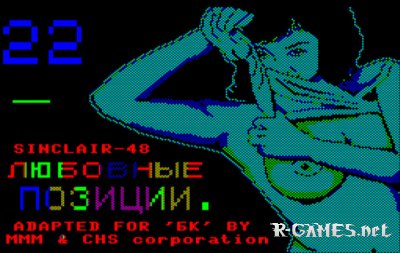
Igri Dlya Bk 0010
Open source emulator of 16-bit PDP-11-compatible Soviet home computers Elektronika BK-0010/11M for Android platform. Igraj The Sniper 2. Dobio si zadatak snajeprista. Potraži neprijatelje i neutraliziraj ih.
Recently I quite occasionally found some sites dedicated to BK-0010 -- the first (and, I'm afraid, last) mass-produced soviet home computer. Oh, the feel of nostalgia. Political science theory and practice by mazhar ul haq pdf download 2017. Do you remember the golden time, when if somebody was in need of certain software, he did not go to Gorbushka to buy a pirated CD, but just wrote it himelf? Some technical data for BK-0010: CPU: K1801VM1, analog of DEC LSI-11; RAM: 32 Kb (normally 16 Kb usable RAM + 16 Kb reserved for videobuffer) ROM: either FOCAL interpreter + MSTD (monitor/debugger), or BASIC Video: 256 * 256 * 4 colors (color mode) or 512 * 256 (B/W mode) Sound: software-controlled squeaker External storage: tape recorder Some screenshots: LOGO interpreter at work Cool multicolor demo.
Well, Spectrum clones had using only Western CPU 'Z-80A', and design wasn`t 1:1 copy from original ZX, I rather say what Soviet-made Spectrums was 'ZX-compatible' (many models was not 100% compatible, lots of games didn`t work on it )Well, I didn't say what they were 100% clones -- they were not. For example, all of them seem to have something absolutely different from original Spectrum 'ULA' (simple microchip responsible for generating video, controlling keyboard and periferials) -- so they produces SECAM-compatible video output instead of PAL one, as original Spectrum did.
But, anyway, they were almost 100% Spectrum-compatibles, and it was a key to success. GREAT thread!
It is certainly bringing back the memories. I used to play with LOGO for hours on Apple II back in the computer lab days (mid-late 80s). My first computer was an Atari XE, probably around 1987, then I got an Apple IIGS in 1989. First PC was in 1992, and I quickly learned how to build them.
I haven't been 'into' PC hardware for about five months and already I'm completely lost with the new stuff. It just changes so fast. All my old PC buddies make fun of me because now the only computer I use is my Apple iBook G4.
But it is really, really neat to learn that the Soviet Union produced home computers, as Western propaganda would have us believing you still had computers the size of a Ural truck in the 1980s! It reminds of the Soviet joke, 'Our watches are the fastest, our computers the biggest!'
Anyhow, really cool thread, guys. Just over three weeks until I arrive in Moscow!
Vilnius BASIC on a BK-0010.01 The BK series was essentially a barebones machine, without any peripherals or development tools. The only available at the launch (except ) was an included magnetic tape with several programming examples (both for BASIC and ), and several tests. The ROM firmware includes a simple program to enter machine codes, BASIC and FOCAL interpreters.
While the BK was somewhat compatible with larger and more expensive professional model and industrial like the series, its 32 KiB memory - of which only 16 KiB was generally available to programmers - (an extended memory mode supported 28 KiB, but limited video output to a quarter of the screen) generally precluded direct use of software for the more powerful machines. The DVK became a popular development platform for BK software, and when the BK memory was later extended to 128 KiB, most DVK software could be used directly with minimal changes. Developers quickly filled this niche, porting several development tools from DVK. This led to an explosion of homebrew software, from and to. Most BK owners expanded the built-in RAM to at least 64 KiB, which not only allowed easier software porting from more 'grownup' systems, but as these upgrades often included controllers, creating a one's own became something of a competitive sport in the BK scene. Games and communities also flourished, as its anemic graphics were offset by a powerful CPU. One of the was, although officially the computer was shipped with, a modification of.
Hardware [ ] The machine is based on a powerful (for the time) 16-bit single-chip CPU, clocked generally at 3 MHz. It is almost perfectly compatible with 's LSI-11 line, though it lacks and further instruction set extensions. The manufacturer also closely copied the PDP-11's internal architecture.
Each model has one free card slot which is electrically, but not mechanically, compatible with. The first versions has 32 KiB onboard, half of which was used as. That is extended to 128 KiB in later models, with video memory extended to two 16 KiB pages.
Video output on all models is provided by the, a rather spartan chip. It is actually a standard 600-gate with a VDC program that allows for two graphic video modes, high-res (512×256, monochrome) and low-res (256×256, 4 colors), and supported hardware vertical.